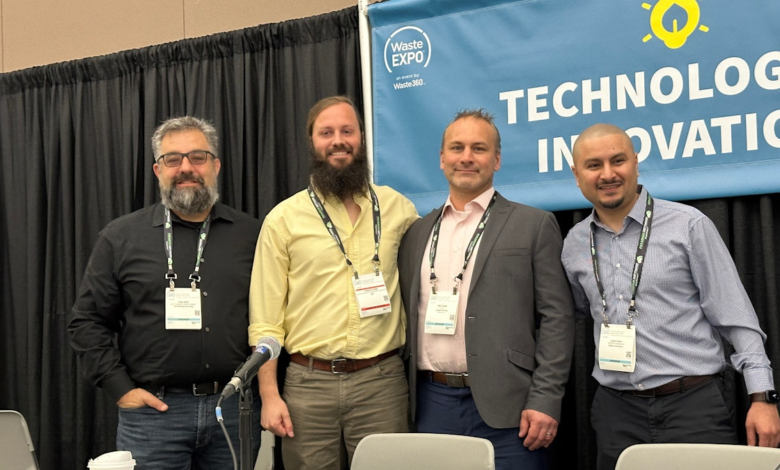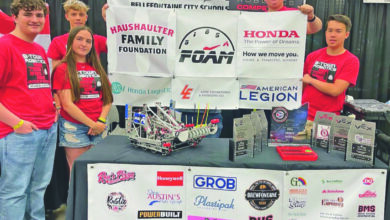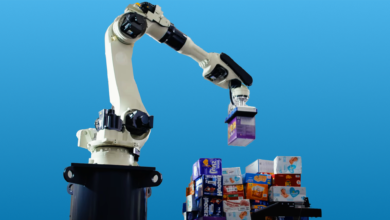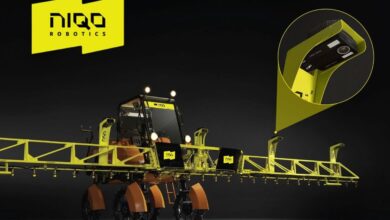Live at Waste Expo: Brands as Beneficiaries of MRFs’ AI Robotic Sortation Data?

At Waste Expo today in Las Vegas, MRFs and recovery facilities weighed in with early returns on emergent AI-based robotic sortation systems. Facilitated by The Recycling Partnership’s Chris Wirth, the discussion hinged on a product both created and used by AMP Robotics. Chase Brumfield, site reliability engineering manager at AMP Robotics. He comes from the unique perspective of working for a MRF himself, and being a tech provider; he and his team built some of the pick-and-place robotics sortation systems for his own facilities. Other MRFs and recovery facilities are taking advantage of that tech, including Matt Cougle, COO, of Cougle’s Recycling, and Javier Erazo, district manager, Waste Connections.
It quickly became clear that as AI-based robotic sorters come online, the benefits to the MRFs who use them, like Cougle’s and Waste Connections, are manifest. They’re easily quantifiable and cut across several bottom-line impacting operations. Human labor is hard to find—and frankly, refuse sortation isn’t a glamorous occupation to many people—so AI-based robotic sorters are an automation that helps with labor shortage. Also, sortation is more accurate, leading to cleaner bales. Sortation is faster, leading to more clean bales per hour. And it’s safer when it’s done by pick-and-pace robots than when humans have to reach into sorting lines. Erazo specified needle pricks from improperly dicarted medical ‘sharps’ as one of many hazards that robot end of arm tooling and gripers don’t feel.
But that data should be able to benefit more than just the MRFs and reprocessors/ recyclers. Since the AI can map out what packaging is being recovered, and what isn’t, it should benefit brand owners and CPGs who design packaging to begin with. Consider Amazon Climate Fund’s recent investment in AI-based robotic sortation company Glacier—there’s a reason brands are interested in what that data can tell them. Brands and CPGs have their own sustainability goals to hit, and data telling them how practically recoverable their existing and future packaging design actually are, in the real world would be worth in gold. We got a rare chance to ask that question directly of the technology provider (like we did with Amazon and Glacier last month).
Packaging World: You laid out very specifically how MRFs and how recovery facilities are taking advantage of the data collected (MORE HERE). But I think there’s a lot of untapped potential with that data for brand owners who make the packaging. Most of what you process in your facilities is packaging, so your data can help them learn more about their packages, what gets recovered, what can’t be recovered, what can be learned about things like small formats (are small sizes are falling through the augers?). Have brands approached you about learning more about their packaging. You’re the “dark side of the moon” to them sometimes. But how they could potentially improve packaging? And even if they haven’t done so yet, do you see potential there?
Chase Brumfield, AMP Robotics: Yes, we’ve been approached by multiple [brand and CPG] folks. I’m not in every high-level business conversation about these things, but yes, we’ve created labels specifically to show that we can [use AMP’s AI-based pick-and-place robotic sortation system to correctly sort that package or label.]
From my perspective, the incentive [for brands] hasn’t been strong enough yet, but it’s coming. There’s a lot of regulation across the pond that’s probably going to make its way this way as well, that might force some of that. The tech is 1,000% capable, we’ve proven that it can do it. It’s just a matter of when incentives align with the right partners. We’ll be ready
Chris Wirth, The Recycling Partnership: Extended producer responsibility (EPR laws) and the regulation that is going into place is going to create that level of incentive, and also that level of compliance about this data and its applications. When you’re looking at regulatory environments in California, Oregon, Colorado, very much, data can move to the forefront to do three things.
One, start to manage and help to provide insights on recycling programs, and where those gaps are.
Two, we need it to start to manage the performance of the system, since ultimately, producers [mostly brands and CGs in the current EPR frameworks] have that responsibility. Now, they pay into the system to drive those improvements.
And three, that data can create a level of corporate accountability from [brand owners and CPGs] and packaging, where they can continuously improve, design for recyclability, and also get to the point of truly yielding the levels of material capture that are aligned with the regulation that’s out there.
Matt Cougle, Cougle’s Recycling: And that’s definitely one area that we have seen more and more. The brands are looking to see ‘is this material going to make it through the MRF? What does our packaging look like in the design phase before it’s actually taken to market?’ This is really nice to see for the first time, because I know that’s generally been an afterthought. That’s something that’s refreshing. And part of the area that has been interesting to us; to have those conversations that happens meetings, where they’re concerned about it, and they’re getting some active feedback before they actually put that packaging together.
Javier Erazo, Waste Connections: We hosted several tours for CPG companies and manufacturers in general. We take from start to end and see how that material flows through our system. Or doesn’t. Or ends up contaminating, or in the wrong bunkers based on so they’re there, they’re viewing it in person. It’s not just us complaining, you get to see what your product is doing. Like multi-layered materials, the robot is just going to eject that because it’s just going to contaminate our bales. A packaging designer seeing that really makes a difference. PW



